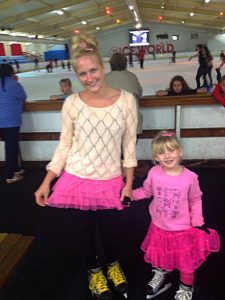That’s the headline in the N.Y. Times, but as I try to tell my 10-year-old (seen here with one of her older sisters as a 4-years-old after the skating coach told her she had to wear figure skates and not hockey skates, and I said, I’m Canadian, your wrong, and when was the last time Russian women successfully competed in ice hockey) there are microbes all around us, we just have to try and understand them.
 I’m still convinced we are all hosts on a viral planet.
I’m still convinced we are all hosts on a viral planet.
And I figure Schaffner should review this book, but he’s a busy dude, so I’ll do it.
From Microbes to Millipedes, Camel Crickets, and Honeybees, the Natural History of Where We Live by Rob Dunn is a collection of the myriad microbial life-forms that take up residence in a typical American showerhead, I’m starting to think maybe that young man was onto something.
With an army of collaborators, Dunn, a professor of applied ecology at North Carolina State University, took samples of the gunk inside hundreds of showerheads, and found a profusion of microbial fauna. Tap water itself, he writes in the chatty, informative “Never Home Alone,” teems with amoebas, bacteria, nematodes and crustaceans. As the water passes through the showerhead, these microbes lay down a kind of scaffolding known as biofilm to protect themselves from getting washed away with every ablution. They make the biofilm “out of their own excretions,” Dunn writes bluntly. “In essence, by working together, the bacteria poop a little indestructible condominium in your pipes.”
It gets worse. Filtered through that poop-biofilm, the water that washes over you, as you supposedly scrub yourself clean, might contain not only all those harmless amoebas and nematodes but a few bacteria that can be dangerous — in particular some species of Mycobacterium, cousins of the Mycobacterium that causes tuberculosis. And the pathogens are there because we provided the perfect breeding ground for them, when we tried to purify our tap water in the first place. Municipal water treatment plants use chlorine and other chemicals that kill off the bacterium’s natural predators, allowing Mycobacterium to thrive. Tap water that comes from a well, in contrast, has never gone through a treatment plant and has a rich microbial life. It might look more dangerous, but it’s actually safer, Dunn explains. All those organisms in well water are themselves harmless, and they tend to fight off the potentially dangerous ones like Mycobacterium — that’s how biodiversity works.
News from the showerhead biome is just one part of this fact-filled, occasionally disgusting, slightly alarming book. Dunn has been involved in an obsessive quest to document the tiny inhabitants of indoor environments, a project that involves teams of professional and amateur bug-watchers to take samples not only from showerheads but from door frames, refrigerators, hot water heaters, cellars, toilets, pillowcases, all sorts of surfaces from the places we call home. These workers swab and seal, swab and seal, and send their thousands of samples to Dunn’s lab in Raleigh, or to his other lab at the Natural History Museum of Denmark, for an ongoing microbial census.
